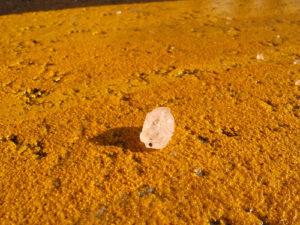 Guest Author: The following post was originally on ArtBistro.Monster.com
Guest Author: The following post was originally on ArtBistro.Monster.com
Sooner or later, it’s bound to happen – that person that you’ve just been dying to have come to your studio or look at your portfolio finally does… and they don’t like what they see.
But instead of being crushed by the experience, how can you respond to negative criticism in a way that turns the whole situation into a positive one?
In this article, I’ve laid out a few things you can do to learn from your visit, rather than simply feeling hurt by it.
As soon as your visit is over, take a few notes on what was said, while everything is still fresh in your mind. Strive for accuracy in these notes – don’t accentuate the parts you want to remember (or are desperate to forget), just write down what factually took place. Think about how the visit unfolded, what happened first, and then what happened next, and record all of that. We have a tendency to dwell on certain moments and to exaggerate them in our mind; if you can get down a clear record of what actually happened, it will help you to follow up with the information you received in a positive way.
Be Honest with Yourself
Once you have this information down, think back a little bit to the way you were feeling right before the critique. Ask yourself what your expectations for the visit were – and be really honest with yourself. Sometimes we set our sights so high that anything less than what we dreamed of sounds like a total disappointment. If you were determined to get a solo show out of a gallery director visiting your studio, you might be crushed if he or she simply concluded the visit with “Let’s keep in touch.” This is unreasonable – there are many very plausible reasons why someone might not jump on your work right away, and only one of those reasons is that they don’t like it.
Search for Constructive Criticism
When you come to the point where you feel as though you’ve recorded what happened accurately and really considered your expectations (and perhaps taken a break for a little while, if it was an especially difficult critique for you), it’s time to really start to take the visit apart in your mind. Think about the substance of the conversation. Did the person give you constructive criticism, maybe even tossing in some concrete solutions to problems that they saw? If that’s the case, acknowledge that while they didn’t really connect to your work, at least they think you’re up for improving it down the road – in fact, it sounds like they really want you to succeed, even if they don’t feel like you’re succeeding right now. This is the kind of criticism you should take very seriously, because it sounds like this person really has your best interest at heart.
Take Some Things with a Grain of Salt
But were the things they suggested totally out of left field and not at all anything you would ever consider? In that case, maybe you and your visitor just have other things in mind for your work. You ought to respect their opinion but take it with a grain of salt and realize that the two of you may never see eye to eye. It can be an amazing experience for an abstract painter to get a critique from a photorealist painter, but only if they acknowledge and respect from the beginning that they both approach their practices very differently. You can learn a lot from these conversations, but that doesn’t mean that you have to incorporate everything suggested into your work.
They May Be Petty or Plain Mean
What about the worst-case scenario, that the person looking at your work became petty or just plain mean in their criticism? This sort of thing only happens very rarely – but the truth is, it does happen. If it does, you have to acknowledge that there is something else going on in the critique that may or may not have anything to do with your work. This sort of opinion really isn’t going to be helpful to you and, as hard as it is, you’re just going to have to let it go. Acknowledge that at the very least, you have learned a valuable lesson – not to spend your time trying to chase after that person anymore. As hard as it might be, you have to simply lick your wounds and get right back to work.
Send Thank Yous When They’re Due
If the visit went any way other than the very last scenario, it can be helpful to send a thank you note to the person who visited your studio. Doing so gives you some closure to the experience and allows you to take the high road and be a professional. Remember that even though they didn’t especially like what you were up to, they did make time to come by and see you. Keep the door open as much as you possibly can.
Reach Out to a Friend
Lastly, talk to a peer you respect about the situation. Share with them what happened and ask for their honest opinion. Don’t be embarrassed to reach out to others about this – remember, this sort of experience happens to everyone sooner or later. But get some feedback and see if the critique you received has some merit, or if it’s the kind of information you should simply disregard. Getting an outside opinion from someone you trust can be crucial to understanding what happened.
Above all, remember that the road before you as an artist is very, very long and a negative critique is only one of the many experiences you will face. Take it as a learning experience and not a setback. Take a deep breath, let it go, and then get back to making the work that you know in your heart you have to make.
*****
I hope these tips help you next time you are faced with negative criticism! ~Lori
PS. I hope to meet you on Twitter and Facebook (If you want to see what I paint, please check out my paintings)
Here are some other helpful posts:
How to Prepare Your Studio for Art Collector Visit
How Not to Clean an Oil Painting
10 Tips to Bring Visitors to Your Art Fair Booth or Open Studio
Helpful Ways to Negotiate and Set Your Art Prices
How to Stage Your First Art Exhibition
12 Compelling Reasons Why Artists Should Use Twitter
Paint Your Own Social Media Portrait
Focus and Plan to Paint!
Boost Art Productivity with Short Studio Sessions
7 Ways to Improve Your Luck as an Artist
10 Tips to Save Money on Art Supplies











As an artist my artworks are out there in the public domain at the risk of rejection by both the general public and the art galleries who are inundated by waves of hopefuls also trying to reaching out through their art.
We, as artists’ need to realise that everyone faces rejection and we are all going to be rejected by someone, somewhere. Just do not let this rejection kill your personal creative art-vision, that thing that compels you to be an artist.
Rejection is nothing new, but it still does not feel good. As sensitive as artists are to their subject matter, in order to bring their work to the world, they must cultivate a disapproval-resistant skin or simply put a thick skin. Artists need to develop their passion along with an attitude that will not look to others for approval.
Art is so very personal that we often see it as representing ourselves. So when it’s torn to shreds or even mildly criticized, artists can be devastated with their egos taking a knock.
As an artist you have to be open to criticism; there’s no way around it. And if you’re in business you need to welcome it and respond to it. Particularly if your business is selling your own art because your confidence will inspire collectors to purchase it.
You need to maintain that perspective that not everyone is going to like your work. Not everyone likes mine and I don’t care, its their loss etc. Because I only need a few select collectors every year to like my art just enough to buy it. Those are my angels who support my art-vision enough for it to continue…